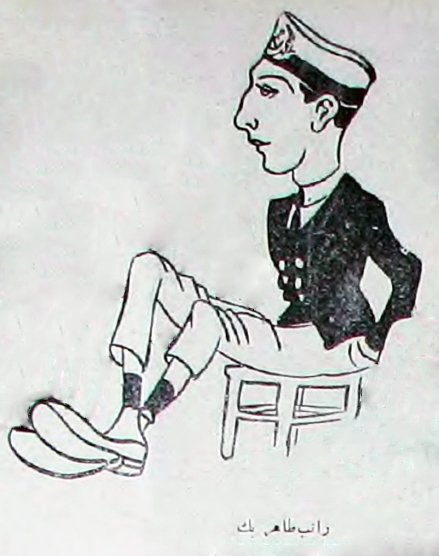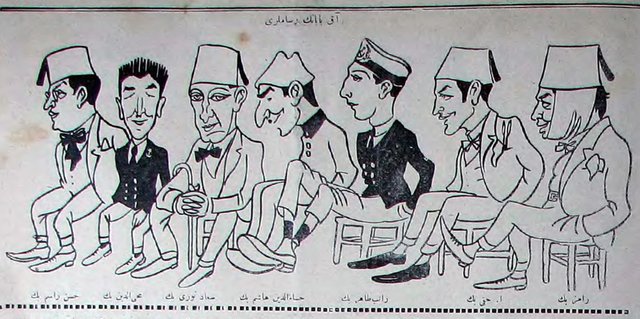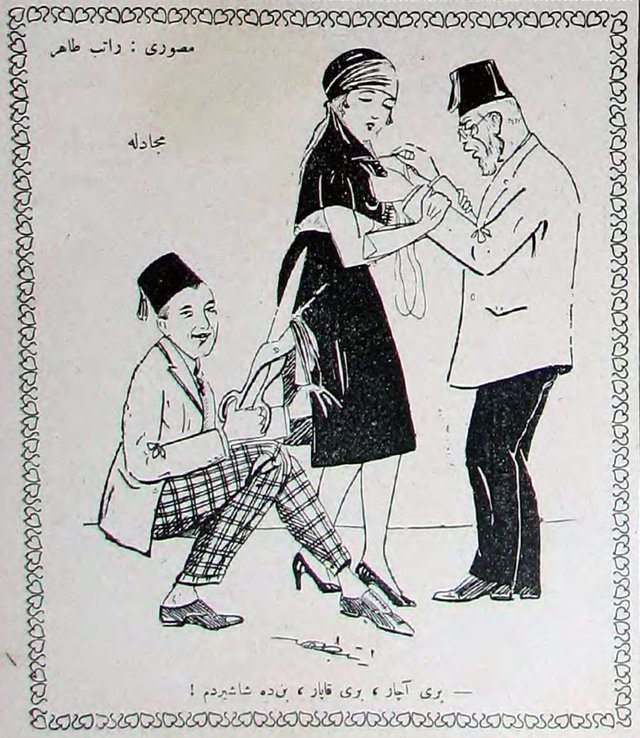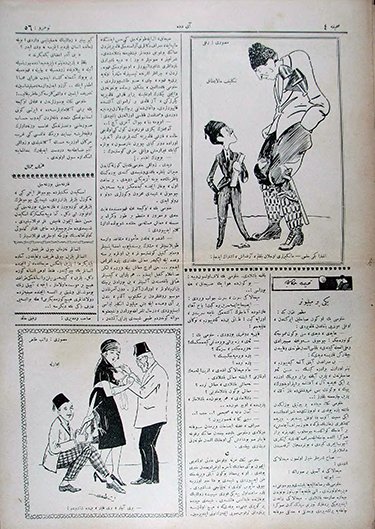95. Today in 1920s Turkey: Turkish Cartoonist Portraits and Profiles (Part III: Ratip Tahir Bey)

(Portrait of Ratip Tahir, Akbaba or “Vulture/White-Bearded Old Man,” 7 June 1923, no. 53, page 5.)
Several posts ago I introduced a cartoon published in the popular magazine Akbaba that depicted the seven artists employed by the magazine (see 92. Turkish Cartoonist Portraits and Profiles: Part I). This cartoon was the basis for a seven-part series examining each of the artists, their oeuvres, and lives. Moving from right to left we looked at Ramiz Bey followed by İsmail Hakkı Bey. Today’s post considers the third artist, Ratip Tahir.

(Akbaba's cartoonists, Akbaba or “Vulture/White-Bearded Old Man,” 7 June 1923, no. 53, page 5.)
Ratip Tahir was born in 1904 in Ottoman Istanbul. At the age of seventeen he graduated at the rank of Captain from Istanbul’s Naval Cadet Academy located on the island of Heybeliada. His background at the naval academy is reflected in the “uniform” and hat he is depicted wearing in the portrait above.
According to his Vikipedi page (Turkish Wikipedia) Ratip Tahir’s first cartoon was published in the satirical journal, Aydede in 1922. Since Vikipedi did not provide further details concerning his earliest work I set off to see, based on this information, if I could find this artist’s very first cartoon by surveying each issue of the magazine from 1922. Aydede was published twice per week and included roughly 5-8 cartoons per issue. Reading through the digitized Hakkı Tarık Us Collection, I diligently checked each cartoon for his signature and finally, found his first gem in the 13 July 1922 issue. See below:

(Ratip Tahir’s first cartoon, Aydede, 13 July 1922, no. 56, page 4.)
This rather cheeky cartoon entitled “Struggle” or Mücadele features an attractive woman caught between two male figures: a fatherly older man standing before her sewing up her collar to conceal her skin and a young man seated behind her cutting a slit in her skirt with a giant pair of scissors to expose more skin. The cartoon bluntly illustrates the unwinnable plight of the modern woman who is expected by (male-dominated) society to be both modest and alluring. The text below the cartoon presumably voices the woman’s concerns: “One will open it, one will close it, even I am confused” (Biri açar, biri kapar, ben de şaşırdım!). The artist’s signature is located below the feet of the young man. His name also appears in plain text in the cartoon’s upper left corner.

(Entire page, Aydede, 13 July 1922, no. 56, page 4.)
In addition to Aydede, Ratip Tahir’s cartoons appeared with regularity in other magazines such as Akbaba, Zümrüdüanka, and Karagöz between 1922 and 1925. In 1926 he was sent to Paris to study art for two years with the support of Prime Minister İsmet İnönü who must have had a good sense of humor since a year earlier the same Ratip Tahir rendered him as a sultry woman in a cartoon published in Zümrüdüanka! See: 76. The Cartoonist’s Armoury, Part 1 of 3 (16 April 1925). Although, Zümrüdüanka, the provocative magazine that published that cartoon, happened to shut down a week after that particular issue hit the newsstands.
In 1934 Ratip Tahir adopted the last name “Burak” in accordance with the Surname Law. In the second half of the 1930s through the 1940s he lived in Ankara and published cartoons for the newspaper Ulus. He also provided illustrations for popular historical serials, comic strips, and graphic novels. He returned to Istanbul in the 1950s and his cartoons were published in Hürriyet and Yeni Sabah. Famously, in 1956 his “Oldu da Bitti Maşallah” cartoon earned him a prison sentence of 16-18 months (depending on the source). Ironically, the cartoon was about censorship of the press, as it depicted a young boy labeled “Press” (Basın) crying while being circumcised by members of the current administration.
Fortunately, he recovered from this setback, as he briefly served in Parliament in 1960 as a representative of Istanbul. He passed away in Istanbul on 28 October 1976.
The first Turkish public broadcasting station, TRT (Turkey Radio Television) recorded an interview with Ratip Tahir Burak and has made it available online for our viewing pleasure. Click here to watch Ratip Tahir Burak narrate the story of getting his first cartoon published. I admit, watching him articulate the excitement and pride he felt upon seeing his first cartoon in print brought tears to my eyes.
Finally, as fate would have it, Today in 1920s Turkey has already examined numerous cartoons from this artist’s oeuvre. To get a better feel for his earliest works I recommend browsing through the below links:
89. Form Letters for Lovers (31 May 1923)
78. The Cartoonist’s Armoury, Part 3 of 3 (16 April 1925)
77. The Cartoonist’s Armoury, Part 2 of 3 (16 April 1925)
76. The Cartoonist’s Armoury, Part 1 of 3 (16 April 1925)
62. Istanbul’s Dance Problem (16 February 1924)
37. Wife and Mother-in-Law Rivalry (8 December 1924)
32. Turkey to Chester Concession: Thanks but No Thanks (15 November 1923)
25. Job Opening: Brothel Manager (9 October 1924)
In addition to Vikipedi, Mizahhaber.blogspot.com, tufs.ac.jp, and trtarsiv.com the following additional source was consulted:
Memiş, Şefik and İbrahim Yarış. “Ratip Tahir Burak.” In: İstanbul’un 100 Karikatüristi, 37-38. İstanbul: İstanbul Büyükşehir Belediyesi Kültür A.Ş. Yayınları, 2010.
Title Correction: "Part IV"